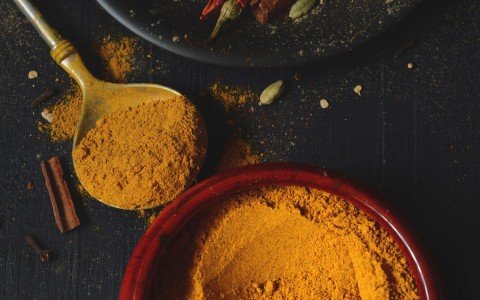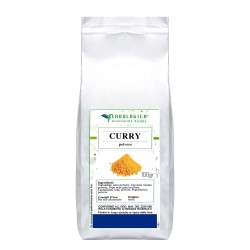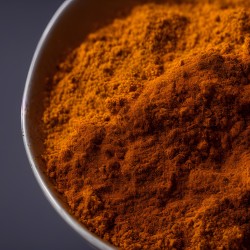
Curry in polvere come usarlo e i suoi benefici
Sei alla ricerca di un modo per aggiungere un tocco di sapore e benessere alla tua cucina?
Allora non cercare oltre: il curry è la risposta che stai cercando.
Questa miscela aromatico di spezie è una delle meraviglie culinarie più amate al mondo ed è anche piuttosto salutare.
Originario dell'India, è conosciuto per il suo caratteristico colore giallo e il suo ricco sapore speziato.
Ma non è solo un'esplosione di sapori: contiene anche una serie di proprietà benefiche per la salute.
Stimola la digestione, riduce l'infiammazione e potenzia il sistema immunitario.
Inoltre, alcune ricerche suggeriscono che alcune delle spezie presenti nel curry, come la curcuma e il pepe nero, abbiano anche potenziali effetti anticancro e antinfiammatori.
Ma come sfruttare al meglio il potenziale del curry in cucina?
In questo articolo scoprirai alcuni modi deliziosi per utilizzarlo nei tuoi piatti e godere dei suoi benefici per la salute.
Preparati a esplorare nuovi sapori e migliorare il tuo benessere con questa incredibile spezia.
Cosa è il curry?
E' una miscela di spezie originaria dell'India, che viene utilizzata per insaporire molti piatti tradizionali indiani.
È composto da una combinazione di diverse spezie, che possono variare a seconda della regione e della tradizione culinaria.
Le spezie più comuni utilizzate nel curry includono la curcuma, il coriandolo, il cumino, il pepe nero, il peperoncino e il cardamomo.
Questa combinazione di spezie gli conferisce un caratteristico colore giallo e il suo sapore ricco e speziato.
Breve storia del curry
Ha una lunga storia che risale a migliaia di anni fa.
Le prime tracce risalgono all'antica civiltà dell'India, dove veniva utilizzato come spezia per insaporire i cibi.
Nel corso dei secoli, ha iniziato a diffondersi in tutto il mondo grazie al commercio e alla colonizzazione.
Oggi, è popolare in molte cucine internazionali e viene utilizzato in una vasta gamma di piatti, dalle zuppe, di carne o verdure.
Diversi tipi di curry
Esistono molti tipi diversi di curry, ognuno dei quali ha le sue caratteristiche distintive.
Alcuni più popolari includono il curry giallo, il curry rosso, il curry verde e il curry massaman.
Ogni tipo ha una combinazione unica di spezie e ingredienti, che conferiscono loro un sapore e un colore caratteristici.
Il curry giallo, ad esempio, è fatto con curcuma, coriandolo, cumino e pepe nero, mentre il curry rosso è fatto con peperoncino, coriandolo, cumino e pepe nero.
Benefici per la salute del curry
Non è solo delizioso, ma offre anche una serie di benefici per la salute.
Una delle spezie chiave del curry, la curcuma, contiene un composto chiamato curcumina, che ha potenti proprietà antinfiammatorie e antiossidanti.
La curcumina può aiutare a ridurre l'infiammazione nel corpo e può essere utile nel trattamento di condizioni come l'artrite e le malattie cardiache.
Inoltre, alcune ricerche suggeriscono che la curcumina potrebbe avere potenziali effetti anticancro, aiutando a prevenire la crescita delle cellule tumorali.
Curry come miscela di spezie
E' una miscela di spezie che combina diverse erbe e spezie aromatiche.
Questa combinazione unica di spezie conferisce al curry il suo sapore caratteristico e lo rende perfetto per una varietà di piatti.
Oltre alla curcuma, che conferisce il suo colore giallo, alcune delle spezie comuni che si trovano nel curry includono il coriandolo, il cumino, il pepe nero, il peperoncino e il cardamomo.
Ognuna di queste spezie aggiunge un sapore unico e può essere regolata in base alle preferenze personali.
Ingredienti comuni del curry
Oltre alle spezie, può contenere anche una varietà di altri ingredienti, a seconda della ricetta e della tradizione culinaria.
Alcuni degli ingredienti comuni che si trovano includono cipolle, aglio, zenzero, pomodori, latte di cocco e foglie di curry.
Questi ingredienti aggiungono ulteriore sapore e consistenza e possono essere combinati in modo creativo per creare una vasta gamma di piatti deliziosi.
Come usare il curry in cucina
Ci sono molte modi deliziosi per utilizzarlo in cucina e sfruttare al meglio il suo sapore e i suoi benefici per la salute.
Ecco alcune idee per iniziare:
Curry di pollo:
Prepara un gustoso curry di pollo mescolando il curry in polvere con pollo tagliato a pezzi, cipolle, aglio, zenzero, pomodori e latte di cocco.
Lascia cuocere a fuoco lento finché il pollo non risulta tenero e il sapore del curry si è amalgamato perfettamente con gli altri ingredienti.
Curry di verdure:
Se sei vegetariano o semplicemente ami le verdure, puoi preparare un delizioso curry di verdure.
Scegli le tue verdure preferite, come patate, carote, piselli e fagioli verdi, e cuocile in una miscela di curry in polvere, cipolle, aglio, zenzero, pomodori e latte di cocco.
Servi il curry con del riso basmati per un pasto sano e soddisfacente.
Curry di gamberi: Se ami il pesce, puoi provare a preparare un curry di gamberi.
Mescolalo con aglio, zenzero, cipolle, pomodori e latte di cocco, quindi aggiungi i gamberi e lascia cuocere finché non sono ben cotti.
Il sapore speziato si sposa perfettamente con il sapore dolce dei gamberi.
Ricette di curry per principianti
Se sei nuovo al mondo del curry, potresti voler iniziare con alcune ricette semplici e facili da preparare.
Ecco alcune ricette per principianti:
Curry di ceci:
Questa ricetta semplice ma deliziosa prevede l'utilizzo di ceci in scatola, curry in polvere, cipolle, aglio, pomodori e latte di cocco.
Mescola tutti gli ingredienti in una pentola e lascia cuocere a fuoco lento finché il sapore del curry si è amalgamato con i ceci.
Servi il curry di ceci con del pane naan per un pasto completo.
Curry di lenticchie:
Le lenticchie sono una fonte eccellente di proteine e sono perfette per un curry vegetariano.
Cuoci le lenticchie con curry in polvere, cipolle, aglio, zenzero, pomodori e latte di cocco per creare un curry saporito e nutriente.
Servi il curry di lenticchie con del riso per un pasto equilibrato.
Curry di tofu:
Il tofu è una valida alternativa alla carne e può essere utilizzato per preparare un delizioso curry vegetariano.
Taglia il tofu a cubetti e cuocilo con curry in polvere, cipolle, aglio, zenzero, pomodori e latte di cocco.
Il tofu assorbirà il sapore del curry, creando un piatto saporito e ricco di proteine.
Ricette di curry provenienti da tutto il mondo
Oltre alle ricette tradizionali indiane, ci sono molte altre ricette provenienti da tutto il mondo.
Ecco alcune ricette da provare:
Curry giamaicano:
Il curry giamaicano, noto anche come "jerk curry", combina il sapore del curry con spezie giamaicane come la cannella, la noce moscata, la pimenta di Jamaica e il peperoncino scotch bonnet.
Questo è spesso preparato con pollo o capra e viene servito con riso e fagioli.
Curry tailandese:
Il curry tailandese è noto per il suo sapore piccante e l'uso di ingredienti come il latte di cocco, la pasta di curry e le foglie di lime kaffir.
Questo curry può essere preparato con pollo, gamberi o verdure ed è spesso servito con riso al gelsomino.
Curry giapponese:
Il curry giapponese, chiamato "kare raisu", è un curry dal sapore leggermente dolce e aromatico.
È spesso preparato con carne di maiale o manzo e viene servito con riso bianco.
Il curry giapponese è un piatto popolare in Giappone e può essere facilmente trovato nei ristoranti di sushi e nelle strade di Tokyo.
Conclusioni
E' un'esplosione di sapori che offre una varietà di benefici per la salute.
Utilizzandolo in cucina, puoi aggiungere un tocco di sapore speziato ai tuoi piatti e godere dei suoi effetti positivi per la salute.
Sperimenta con diverse ricette e scopri quale tipo ti piace di più.
Che tu sia un principiante o un esperto di cucina, è una spezia che non può mancare nella tua dispensa.
Preparati a esplorare nuovi sapori e a migliorare il tuo benessere con questa incredibile spezia indiana.
Le informazioni contenute in questo articolo sono solo a scopo informativo e non intendono sostituire il consiglio medico professionale.
Si consiglia di consultare il proprio medico o un professionista della salute qualificato prima di apportare modifiche alla propria dieta o regime alimentare.



